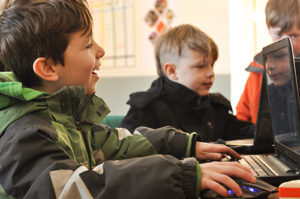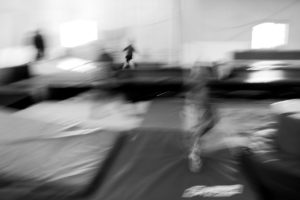Hark, the school year beginneth! The long, languid, dreamy days draw to a drier, crisper end. Time to get back to reality. How utterly gratifying to return to a school designed to support young people’s humanness. How invigorating to be able to focus on such a vital task, rather than on, say, sprawling tomes of byzantine standards. Hallelujah. Summer fades, yet my mood endureth.
You know, our school is often misunderstood (big surprise, I know). It’s true that we’re different, indeed we are the alternative to everything else. But sometimes we are accused of living in a kind of Rousseaun fantasy – summer forever. Time frittered away in reverie while the rest of everyone is busy learning how to dominate the real world. I mean the markets. Or whatever. Ideas like this might even pop into the heads of Sudbury parents from time to time, or staff, or even students. But this unimaginative thought ignores the complexity, the history, and the evolution, of our human reality. In fact, HVSS is the most real place I know.
I want to tell a story from my own summer, about learning – a personal learning experience. I was lucky enough to get to spend five weeks on the coast of Maine on property my grandparents bought almost 70 years ago. The spirit of the land remains strong; like our Mountain West, Maine retains its natural power despite intensive human habitation. It’s inspiring, and I find that it sparks the imagination. Early on in our time there, I decided to listen to an absolutely devastating history of the Western Front of WWI – not sure why, going with my intuition – I’m impressionistic with my interests, that’s how I learn. I remembered reading about it in high school, but I only got the dried out basics: trenches, gas, it got bad out there. Basically, all I learned was that WWI happened, and it was important. In July when I started listening to this history, put together by a passionate and insightful reporter, and which included lots of first-hand accounts of the combat, I couldn’t stop. I binge-listened. One day I did almost eight hours of audio. I wandered around in a kind of daze. I lay in the grass and stared vacantly into the vault, I watched the tide coming in, II stroked my baby’s wispy hair for hours. It was really horrific stuff, much worse than I had thought. A few times in the afternoon I went running on trails through the woods, and I couldn’t help imagine being in the forests of Flanders, shells smashing into the pines as I ran, faster and faster, men (and boys) on the ground everywhere, clutching at the rocks, the moss, the mud. At night, lying in bed, I composed letters to my family and wife and children from a bomb shelter in Verdun, where I was waiting for my turn to jump out of a trench, just as the apocalyptic German bombardment of that city began. A friend there, in Maine that is, not Verdun, gently accused me of appropriating the worst misery of millions of people for my own entertainment, but I didn’t see it that way. I thought of it as a way of witnessing, of honoring the people who were there, and of looking closely at what people are capable of. It was all very real for me. The quality of the history, along with the space and time I was afforded both to find what was alive for me and to immerse myself in it, allowed me to have an amazing educational experience, because that’s how I learn. This is what’s available to our students here at HVSS: we offer the “real world” insofar as our students have access to all the ways they “really” learn.
Wow, I can’t wait for the first day of school – what fun it will be! The staff here are so lucky to be able to interact with young people, who everywhere lead the world in play, enthusiasm, hopefulness, and closeness, in an environment of fundamental equality. How satisfying, and what a relief, to be permitted to treat them with complete respect instead of being expected to compel them to perform tasks and regulate their behavior with carrots and sticks. What an almost mischievous joy it is to protect their access to money and political power within the school, which they are systematically denied elsewhere. And- even that last, totally outlandish-sounding proposition is totally “real.” The hunter-gatherers from whom we descend knew that young people are sovereign, too – we lived guided by such principles for hundreds of thousands of years; it’s etched indelibly in our biology. Perhaps that’s why young people expect to be treated with kindness, to be cooperated with, and to be given assistance. And – how fascinating it will be to watch our students learn in all their myriad ways, many of which do not look to our narrow perspectives like “real learning” at all. But! But but but but – no time is wasted here. If you’ve ever been for a visit, you may disagree – perhaps you’ve observed loafing, television watching, and texting and tweeting and instagramming. But even during these seemingly trivial activities, though, something important is happening, at least and especially when it’s happening here, where young people are candidly expected to be powerful and intelligent, where they are trusted as a matter of course to direct their own lives. The marinade is mixed and set – would you suggest the steak wastes time marinating? An inelegant metaphor perhaps, but it gets the job done. Just being here, where their full humanness is seen and honored, is, at certain points in individual students’ process, enough.
Speaking of steak, marinade, and the real world, I recently was helped at Fleisher’s Craft Butchery by one of our recent graduates, Colin Thrapp. He had just returned from a solo foodie trip to Norway. Since graduating two years ago he’s worked at Outdated Cafe and now he’s with the butchers. He’s out there in the real world, being treated with the respect he expects, learning real skills from experts, and, I might add, offering excellent customer service (thanks, Colin). He may or may not go to college – I don’t know, I don’t care, I’m just happy that he sees options where I saw only college, that the world is his oyster, that he is guided by his own genius and not any arbitrary external standards. That’s what our people look like. They’re just so themselves, just so…real.
So everyone, it’s that time of year: September, back to school. The bells are tolling, and teachers and students all over our surreal country are waking up nauseous. But not us. We’re really quite excited for a nice little dose of reality. See you soon.

 The first video game I ever played, in 1990, was a side-scrolling 2D game, the kind in which the protagonist moves from left to right while the screen scrolls by, revealing as it does various obstacles and enemies to overcome and good things to grab. The popularity of this style of game has hardly diminished even as gaming technology has developed NASA-like precision and scope and expansive Tolkienesque narrative and imagery (see for example the nearly infinite detailed galaxy generated by the game
The first video game I ever played, in 1990, was a side-scrolling 2D game, the kind in which the protagonist moves from left to right while the screen scrolls by, revealing as it does various obstacles and enemies to overcome and good things to grab. The popularity of this style of game has hardly diminished even as gaming technology has developed NASA-like precision and scope and expansive Tolkienesque narrative and imagery (see for example the nearly infinite detailed galaxy generated by the game  It’s notable that a few of our gamers also pursue the discipline of parkour, which is usually described as a sport or a movement-art. The idea is to move around obstacles as efficiently as possible, usually with
It’s notable that a few of our gamers also pursue the discipline of parkour, which is usually described as a sport or a movement-art. The idea is to move around obstacles as efficiently as possible, usually with